No Man's Sky Next: the answers to ten burning questions
No Man’s Sky isn't the best at explaining itself, so we've provided the answers to some common questions.
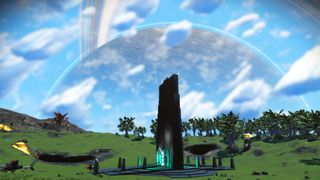
For all the noticeable improvements to be enjoyed in No Man’s Sky's recent Next update, the game is still…obtuse, to put it kindly. Early tutorials do a pretty good job of teaching the basics, but I still feel like there’s a lot of important information the game isn’t explaining. When I’m playing with my friends, we’re constantly bouncing questions off each other in Discord hoping that one of us has banged our head against a problem long enough to discover No Man’s Sky’s vague solution.
But you needn’t be as confused as we were, because we’ve gathered a bunch of answers to these common questions to help you in your travels, both in multiplayer and singleplayer modes.
Multiplayer

So, can people see my base if they’re not in my game?
In short, yes, but only if you’ve uploaded your base. You can upload your base at any time by visiting the base computer. Assuming the online systems are working as intended (which is a lot to ask right now), anybody visiting your planet will be able to see your base as you last uploaded it.
There's no need to worry about vandalism. Visitors won’t be able to edit or destroy your base, and any griefing inflicted by visitors won’t be reflected in your session, unless it’s done by a friend playing with you. Though there’s only a small chance anyone will ever randomly happen upon your base, providing a cozy shelter protected from the harsh elements might just save a life someday!
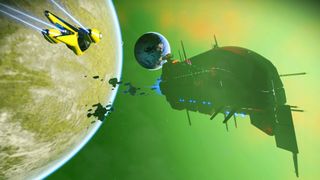
Why can’t I summon my freighter?
There are a couple of reasons this could be happening. Usually, you can command your freighter to make a cool warp speed entrance to almost anywhere in space (even when you're standing on the surface of a planet). But while in multiplayer, the community has already discovered an unfortunate limitation: Only one player’s freighter can exist in a system at once.
The biggest gaming news, reviews and hardware deals
Keep up to date with the most important stories and the best deals, as picked by the PC Gamer team.
If you want to see your own freighter and your friend's is already present, you’ll need to warp to another system before you summon it. If you’re having trouble calling your freighter while playing solo, you likely need to find a larger space for it away from other nearby ships.
Can my friends and I play co-op missions?
Yes! But be warned, they’re kind of buggy right now. Your freighter’s control room has a mission terminal with jobs that your multiplayer compatriots can join you on. The game is a little finicky about making sure everyone gets the mission, but as long as you and your friends are grouped up the mission reward will be shared. These missions tend to be harder than the typical ones, so beware about trying them solo.
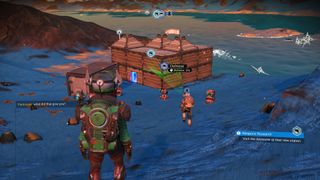
Why can my friends and I make the same discoveries?
Well, that’s not by design. When the discoveries system is working properly, whoever visited a planet first and then uploaded their discovery will be the true founder. The same goes for plants, animals, locations, and districts. Right now, the discovery systems are usually offline or intermittently functional. This has led to my friends and I both discovering the same stuff and there being no clear answer to who will be etched into the planet’s history.
On the bright side, you'll still earn Nanite Clusters with discoveries either way, so these issues don’t impede progress.
Why can’t I warp to the system my friend is in?
It’s probably your warp drive. The game does actually try to tell you this while you're viewing the galactic map, but it’s just vague enough that people are still confused anyway.
Each system is a different type of star. With only the default warp drive, your ship can only travel to yellow stars. Upgrades to your warp drive can be purchased from space stations that enable travel to red, blue, and green stars as well. The colors represent different biomes that will generate in each system type. These harder-to-reach systems contain some of the weirdest planets you’ll find, so it’s an upgrade worth investing in.
Singleplayer
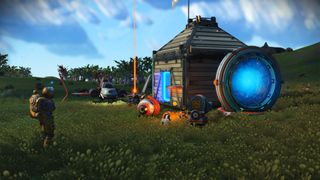
How do I unlock more building parts?
Despite this being part of the initial tutorial, the reveal process for new base building materials is infuriating and vague. You must unlock most of the important parts of base building by slowly revisiting your base computer as it recovers old archives. Every 90 minutes, it’s ready to teach you how to make something else. The other main way to discover more blueprints is by continuing to unlock items in the blueprint analyzer using salvaged technology.
Eventually, buying existing blueprints from the analyzer will unlock new ones. So even though you don’t plan on using three different colored lights and metal hallways, go ahead and unlock them anyway to progress further along the blueprint tree.
If I buy this ship and leave my old one behind, will I lose it?
Let’s break down the three scenarios for acquiring new ships first. You can either buy, exchange, or find a new ship. Buying means you get a new ship but keep your old one as well. Exchanging for a new ship means selling the one you’re currently flying for a trade-in price towards a new ship. Make sure to transfer all your old ship’s inventory before buying, because there’s no going back afterward.
Finding a new ship is done by encountering a crashed ship on a planet. You can add this ship to your collection for free, but it will need repairs before it can fly. When you buy or find a new ship, you don’t need to worry about leaving your other ship behind, and any ship in your collection can be summoned at any time on a planet. If you leave a ship behind in some random desert, it will automatically appear back on your freighter later. It will also keep whatever inventory it already had.
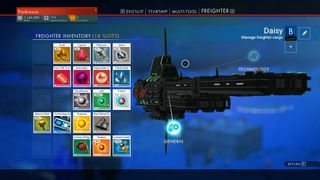
How do I transfer items from my freighter to me?
Well, you can’t, at least not directly. You can beam anything from your suit or ship inventory to your freighter, but you can’t beam it back. (I guess that would be too convenient.)
Instead, there’s a workaround using storage containers. By progressing in the base building quest, you’ll unlock the blueprint for storage containers. Each one has five high capacity storage slots. Your freighter can beam down supplies to the storage containers, which can subsequently be transferred to your inventory by interacting with them. It’s a weird system that creates an extra step in the simple process of trying to sell stuff. Alternatively, you can always park inside your freighter to gain access to its inventory. This might be faster if you simply summon your freighter close to the space station, and then make a pit stop.
What should I sell and what should I keep?
Early in the game, any rare materials you find are better off sold. Yes, there are uses for most of these items in one way or another, but inventory space is precious in No Man’s Sky, so keeping a rare thing you found that will help you build something 30 hours from now just isn’t worth it. In an infinitely generated galaxy, there will always be more resources to be found. Instead, prioritize keeping core elements on hand that make your life easier.
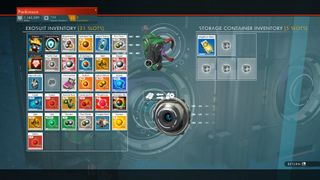
How should I be making money early on?
The game broadly lays out how to make money, but there’s some specific strategies that can be employed to make a healthy income. At space stations, acquire an S-rank upgrade module to your analysis visor. These modules will increase the monetary gains for scanning plants and animals by over three thousand percent, usually. That means scanning a particularly large tree or animal could give net you an easy 200,000 units. This is my favorite way to casually make good money while doing something I already enjoy—exploring a new planet.
Another good way to make money is to find a planet with a lot of Gravitino Balls. These are glowing balls just sitting around that, when picked up, immediately initiate combat with the sentinels. So, grab a bunch out of a pile and then make a run for your ship. Finding a toxic planet abundant in Chlorine is also a lucrative business, but bring some extra hazard protection upgrades to make the toxic storms more bearable.

Morgan has been writing for PC Gamer since 2018, first as a freelancer and currently as a staff writer. He has also appeared on Polygon, Kotaku, Fanbyte, and PCGamesN. Before freelancing, he spent most of high school and all of college writing at small gaming sites that didn't pay him. He's very happy to have a real job now. Morgan is a beat writer following the latest and greatest shooters and the communities that play them. He also writes general news, reviews, features, the occasional guide, and bad jokes in Slack. Twist his arm, and he'll even write about a boring strategy game. Please don't, though.
Most Popular


